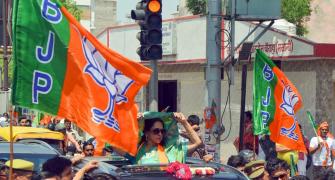Sandeep Dasgupta of Deutsche Bank believes that Bank of Japan's rate stance has been along expected lines. Dasgupta does not expect Bank of Japan to up rates before Q4CY06, early 2007.
According to him, retail flows from Japan have slowed down. He feels that Japanese investors are not in a hurry to up equity exposure.
Dasgupta is overweight on IT, capital goods, power and engineering sectors. However, he informs that the company has low exposure to midcaps.
Excerpts from CNBC-TV18's exclusive interview with Sandeep Dasgupta:
Since you concentrate on flows that come in from Japan and the agenda that they have there, what is the view emerging on India in the context of post earnings and the crash, after May?
If you look at the market in Japan post May 12, it has fallen by about 6% as opposed to Indian markets, which fell by about 9% and Dow Jones' broad market Index, which fell by about 2.5%.
So despite the economy, which was expected to do well; although the numbers, which appeared for June quarter was not so encouraging, Japan's market has not done too well. In my opinion, the retail flows, which was coming to India from Japan has slightly slowed down. The reason being that the risk appetite within the retail investor community has definitely gone down.
Going ahead, will we have to get used to a lower liquidity with the Bank of Japan's move of hiking interest rates, which they did last time around? Is there a fair amount of ambiguity in the air even now?
I don't think there is too much of ambiguity as the rates have remained unchanged today. That was the expectation and given the fact that the voting was 9:0 in the Bank of Japan's supervisory committee, I don't think they would increase rates in a hurry.
The economy too has not shown very encouraging numbers for this quarter and the US is likely to slow down a bit. I don't think rates will increase in a hurry, it won't happen before the end of Q4FY06 or early FY07.
Do you think Japanese retail investors are getting a little shy of putting money into non-Japan emerging market space. They seemed very keen last year but because of a host of factors, are they becoming a little skittish about it?
I think it is more about sentiments. In general, if you look at Japanese investors, the appetite to increase their exposure to equity into slightly riskier markets like emerging markets including India was definitely high in the end of FY04 and also FY05. But beginning this year, given the fact that the valuations were stressed and what we saw in the month of May, the meltdown and the domestic markets were not doing too well in Japan as well in the last two and half months.
I think the risk appetite has reduced so the propensity to increase their exposure to equity has definitely come down and that will impact
By the same token, has it just been a pause or have you seen any kind of withdrawal of money from the retail traders who were saying that they don't want to take so many risks anymore?
No, we have not seen any major outflows in our funds at least. It's more of market movements. Since the beginning of this year and till today, when I saw the numbers, it has been quite stable.
What about the rest of the money that you run, which is non-Japanese. What are the key take-aways from that universe?
Very frankly, we only advise funds, which are managed out of Singapore, which gets money from Singapore and Japanese investors. Within DWS, we do manage a lot of money in emerging markets out of our Frankfurt office. I really can't comment much on that at this stage.
For the money that you advise, does IT still remain your largest overweight sector in the light of the kind of numbers that you saw this quarter?
Yes, indeed. Right now, we are overweight on IT and slightly overweight on capital goods and that's the view that we share even for our domestic funds. For the near future, we don't see much of slowdown on construction and engineering activity.
So capital goods, power equipment, engineering and cement will be our overweight sectors. Given the way the large IT companies have continued to show earnings growth and given the way margins are improving, and if indeed the developed markets like US slow down, I think there will be a lot more appetite for increasing IT expenditure and that's where Indian companies will benefit. So we are overweight on IT.
Where do you stand on midcaps? You are largely in largecaps but for the last few days, midcaps have started coming back. What is your level of exposure there for your funds?
Our exposure to midcaps is low right now. It is predominately comprises largecaps and very selective midcaps in a few specific sectors.
Have you taken any cash off the table? Are you largely invested in this rally back to 11,000 plus?
Right now, we are invested in about 5-8% cash in the domestic funds. In the Japanese funds, it is mandatory for us to stay invested all the time. Because one of the fund that we advise out of Japan has 10% in Japanese bonds. So that mirrors the cash equivalent.
What is the sense that you get when you talk to investors in the region. Has the mood on emerging markets improved after the relative stability of the last few weeks?
Indeed, the mood has improved. I think India has been looked at slightly differently, given the strong earnings growth expected, even in the next few quarters. I think as far as India is concerned, people are a lot more bullish at this stage.
For more on markets & business, log on to www.moneycontrol.com.







